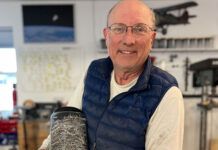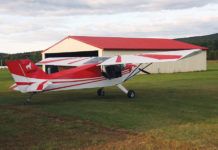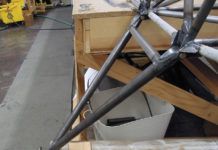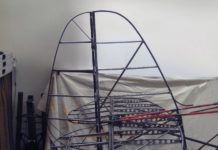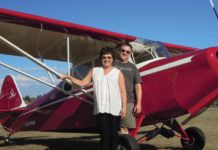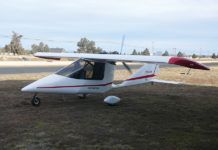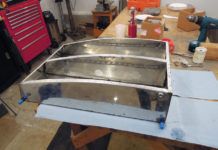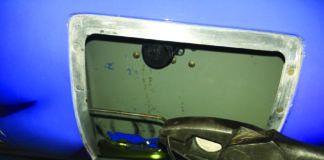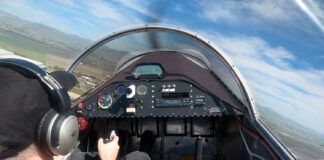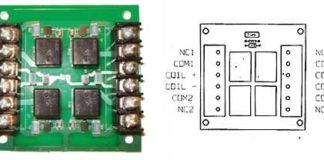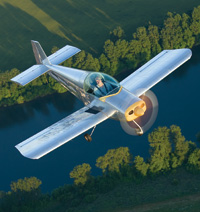
In January 2006, the KK-1 began to come together for the final time. The wing, tail and fuselage were bolted together. The canopy, fastened to the frame, was fitted to the parallelogram slide bars. The rudder cables were hooked up. The engine was hung- which, in our case, meant that two guys lifted the engine up and aligned it with the mounts, small steel tubes with flanges riveted to the firewall.
Early in February we had the major systems hooked up and were looking forward to starting the engine. To that end, we poured a couple of gallons of gas into the tank to flush the system and carburetor. We flushed, all right, but not where wed hoped. The tank promptly leaked in at least three places, which we found mystifying. There was certainly enough sealant in it! There was nothing to do but remove the tank and pressure test it-something we should have done months earlier. We cut a hole in the bottom of the tank, went in and sealed the offending corners and pop-riveted a patch over the hole on the way out. The tank spent a few days curing while we did other tasks. Another pressure check proved our fix.
Fire in the Hole
By now it had been five years since my building partner Ken Krueger and I started this project, something we never imagined when we began. It was getting to the point where we wanted to get the airplane done just so we could get it out of our lives. We definitely needed some sort of boost.
We finally got it on March 2. We bolted on the prop, rolled the airplane onto the ramp, turned on the fuel pump and, for the first time, hit the starter switch. The little VW cranked a few times and spun to life. Hoo boy…it lives!
After a few seconds it settled into a smooth hum. That muffler really did the job, because the engine was very quiet. As Krueger revved it up, there was some noise off the prop, but nothing more than a sort of throaty purr from the exhaust. At half throttle, it jumped the chocks, and we found out for sure that the brakes worked.
Shortly after the taxi tests, we put the airplane on the scales to get some idea of how accurate our predictions were. Besides, Krueger wanted a preliminary weight and balance before he positioned the seat. This was a moment wed been anticipating, both eagerly and with trepidation. I got on my hands and knees and braced my back on the bottom of the wingspar. It was easy to lift a mainwheel off the ground while Krueger slid a digital scale under it. We put another under the nosewheel, set the meter to zero, hooked up the wires and pushed the button.
When we peeked though our fingers, we saw the bad news: 538 pounds. (The final weight, with all components, was 551 pounds.) More than wed hoped, but it could have been worse. An airplane with a 22-foot wingspan, a four-cylinder engine with a muffler, slotted flaps and a tricycle gear that weighs 550 pounds is still a pretty good achievement.
First Flight
Some years ago I became the second person on earth to fly an RV-9A. I wrote an article for the company newsletter about how I appreciated the experience, as Id probably never make the first flight of an entirely new design. But now I had the chance to do exactly that.
I staked my claim to the first flight early on, even though Krueger is probably a better pilot-certainly a better test pilot-than I am. I justified it by noting that I didn’t have young children and I was older; therefore, I had less future to lose and would leave no orphans if it all turned out ugly. This, of course, was bullpucky. I have a wife and two stepsons who are as important to me as any family I could ever have, and nobody knows how long their personal future is. Maybe it has something to do with the fact that my father was a flight test engineer for North American in the early F-86 days and held test pilots in high regard. I am not a risk-taker by nature, and I don’t pretend to understand the psychology at work here. All I know is that I wanted to do it.
But I didn’t do it.
Quietly, Krueger had been preparing for his own first flight in the airplane. He didn’t regard himself as my mentor or my mother, so he left me to make my own preparations. I figured that Id avoid alcohol for a couple of days, study a checklist or two, borrow a parachute, and go fly.
That wasn’t good enough for Krueger. He bought a fireproof balaclava and gloves. He acquired a helmet. He flew spin recoveries and unusual attitude training with Steve Wolf. He actually jumped out of an airplane so he could learn how to use a parachute. He downloaded Google Earth photos of the area surrounding the Aurora Airport and carefully marked possible emergency fields. He prepared contingency and emergency checklists.
Faced with this, I had to reexamine my own preparations. After a long talk with my wife, I realized that I was trying to join an exclusive club without paying any dues. The people who have made successful first flights of new designs took great pains to prepare themselves for every eventuality. I had not. I was going on hope and denial.
I swallowed hard and got out of the way. There was no question about which of us was better prepared. Krueger would make the first flight. On May 17, we assembled at 7:00 a.m. I sneaked the RV-9A out of Vans hangar to use as a chase plane and installed Camilla in the right seat as camerawoman and
Preferred Sharer of Important Moments. Susan and Amy (Kruegers wife and daughter) and Mel Ellis (our engine builder) had video cameras. Krueger donned the paraphernalia, we had a last minute chat on exactly who was going to do what, then he climbed in and cranked the engine.
Naturally, it wouldn’t start.
We pulled the cowl and found that the choke plate was out of position. We corrected that and, with a fresh battery, it fired up instantly. The next morning, the same group assembled. This time the engine cooperated, and we taxied out to Runway 35 at Aurora. I took off first and circled around, lining up a quarter mile behind the runway threshold, and slowed to about 90 mph. We watched as the little silver airplane accelerated down the runway and after 500 feet or so, separated from its shadow. It was…so…cool.
We climbed at about 600 fpm to 4000 feet. We flew some lazy circles, then I pulled up underneath and had a look. There were no liquid streaks, no smoke, no stains-everything looked perfect. Krueger went to the next item on the test card-slow flight and approaches to stalls. That seemed completely straightforward, so he proceeded to stalls. After hanging a few seconds nose high, the airplane dipped and leveled out. The flaps came down, and the nose came up again. This time the right wing dropped about 10 as the nose dipped. Nothing scary, from the outside anyway.
So we learned that it flew, climbed and stalled conventionally. This boded well for the first landing, and so it proved. I circled overhead while Krueger set it down 200 feet past the numbers and made the 950-foot turn off with ease. I landed long and joined the grins. Ellis, especially, was pleased because the engine had run strong and stayed cool. The cabin tunnel surrounding the exhaust hadn’t even gotten warm to the touch. In Kruegers words, the whole flight was anticlimactic…exactly what you want to hear after a first flight.
My Turn
Finally, on May 22, I flew it. Krueger had briefed me that the elevator had a bit of pulse, probably caused by the lack of mass balancing, and to climb at around 70 mph. I worked my way through the checklist. The engine started without hesitation, and I taxied out.
Everything went well on the runup and pre-takeoff checklist, so it was time to go. Full power-well, 55 to 60 horsepower doesn’t exactly jerk it out of the hole-but once it starts moving, acceleration is decent and gets better. I elected to take off without flaps, which would have shortened the run, because I didn’t want anything to do on the climbout other than capture the airspeed. The elevator did feel different-light and a bit vague. Without Kruegers briefing I would have wondered what was going on back there. Even with this little airplane, I found myself slightly behind events, and by the time I started climbing and set the trim, Id already reached almost 90 mph.
I climbed up to 2000 feet and just flew around for a while. I wanted to enjoy
the moment (a long time coming!) and get my senses connected to this machine. It is a light airplane, certainly the lightest Ive flown, (and, I realized after I landed, my first single-seater) and every movement in the surrounding air is transmitted to the pilot, especially through the elevator. This doesn’t mean the airplane is being thrown around or is difficult to fly. It is actually quite stable and docile. Its a bit like a small dinghy compared to a big cabin cruiser-the surrounding motion is much more noticeable even though you are still in control. In this airplane, you have to participate in the atmosphere, rather than subdue it.
I slowed to about 60 mph IAS and lowered the flaps to half. That all seemed normal enough. Below 60 you could hear the turbulent air off the inboard end of the flaps rattling on the thin belly skins. Full flaps made it more pronounced. After finding that it handled nicely with full flaps at Kruegers recommended approach speed of 60 to 65, I decided to leave stalls for the next flight and see if I could land without hurting anything. Landing turned out to be the easiest part of the whole flight-its a baby carriage. The decision to use a nosewheel was a good one.
Flight Test Time
As we proceeded with flight testing, we found that the airplane is reasonably fast-a little over 120 mph if you push it to 4 gph. (If we ever get the landing gear and wheel fairings on, it should gain several more mph.) At 3 gph, it will cruise at just under 100 mph. Stall speeds are in the low 40s, and the big flaps make quite a difference in pitch attitude. Climb rates are leisurely, especially with me in it: 500 to 600 fpm under most conditions. With lighter pilots and fuel loads you can see 800 fpm. Krueger flew it from Aurora, Oregon, to Bishop, California, cruising at altitudes of up to 12,500 feet and averaging 109 mph over the ground.
Yeah, yeah, so much for numbers. Whats it like to fly?
In a word, pleasant. It isn’t overpowered, so the initial takeoff acceleration is moderate. Aft stick has the nosewheel off quickly, and a few seconds later the wing does its thing and off it comes. It all happens at speeds that would seem normal to a Cessna 152 pilot, though it takes considerably less runway. Because the VW turns the other way, it requires left rudder on takeoff and climb.
Once aloft and leveled out, the fun starts. The ailerons are excellent, every bit as good as an RV. Roll is quick and positive and takes almost no rudder to coordinate. Pitch trim is powerful and easy to use. The c.g. doesn’t change much with fuel load, so the airplane feels much the same at different tank levels. Slow flight characteristics are solid and its easy to drive around at 50 mph in perfect control. Power-off stalls are a non-event. The stick goes limp in your hand, the nose drops a few degrees, and as soon as you relax the back pressure, its flying again.
Visibility is superb. The big bubble gives a tremendous view. The nose drops away quite steeply and it took a couple of tries to learn the climb attitude picture.
The landings are just ridiculous. The slow landing speed, excellent sight picture, great low-speed control authority and that tricycle gear make them absurdly easy. The tiny wheels like pavement, but they cause no trouble on a well-kept grass strip. With so little inertia, once the wheels are on, the airplane slows quickly.
We really wanted a quiet airplane, and we seem to have succeeded. The cabin noise is less than most small single-engine airplanes, though you wouldn’t want to fly for long without a headset. The noise print on the ground from 1000 feet or higher is negligible. We cant get our wives to come out and wave when we circle our homes-they never hear us.
But no airplane is perfect out of the box. There were a few anomalies to investigate and fix. We sealed the 0.040-inch gap between the wing and fuselage side, eliminating the low speed rumble. As a bonus the glide and inertia through the landing flare were noticeably improved-evidently the gap had been acting as a vortex generator at high angles of attack.
We also noticed that we could smell exhaust in the cockpit, even with the fresh air vent wide open. We sealed around the flap actuator rods and other small openings in the belly. The improvement was immediate. We added mass balance weights to the elevators, and the imprecise, vague feel disappeared.
We are quite pleased with the engine. It runs well and seems robust and happy, even though it doesn’t exactly overwhelm an airplane this big with power. It is somewhat temperature limited. The stock VW oil cooler mounted on top of the case cant quite keep oil temperatures in check on steady climbs on warm days, so we have to lower the nose and let it cool. In cruise, it is fine. We will be investigating better ducting and more efficient coolers.
Howd We Do?
Way back at the beginning of this adventure, we set ourselves some goals. How well did we meet them? To refresh your memory, they were: A 45-mph landing speed; at least utility category strength (limit load of 4.4 G); it had to carry both of us-not together, but individually; it had to stay in the air for at least 1.5 hours; it had to have sufficient climb performance with me aboard to avoid frightening me; and we could not spend more than $6000. Less would be better.
We came close on the landing speed. We fly final at 55 mph IAS and a tickle of power to keep the descent rate under control. With full flaps and the engine at idle, the KK-1 will develop an impressive sink rate-typical of low-aspect-ratio wings. Touchdowns can be quite nose-high, and rollouts are short.
The airplane will carry either of us. In fact, the cockpit would accommodate much bigger people. The fuel tank holds almost 23 gallons-far more than wed originally envisioned-and at the +/-4 gph burn of the VW, we can stay aloft for 5 hours.
Price is a bit harder to figure because we did have some advantages. Mel Ellis charged ridiculously little for building the engine, Rob Hickman at Advanced Flight Systems has yet to present us with a bill for his wonderful engine monitor, and Jeff and Becki Rodgers at Airplane Plastics keep waving their hands when we try to give them money. Dick VanGrunsven never asked a nickel for using Vans Aircrafts tooling and shop space, and we repaid his generosity by buying all of the hardware at cost with our employee discount! All in all, my best guess is that if someone were to build the same airplane and pay full retail for everything, the cost would be $13,000 to $14,000.
However, if you built your own engine, used simple instrumentation and were handy with a welder, I really think $8000 to $9000 is possible. You could have an airplane for the cost of a used Toyota, a small travel trailer or a decent violin bow. (No, not the violin, just the bow. Don’t ask me how I know!)
Whats Next?
As we mentioned in the beginning of this series, we have absolutely no intention of making plans, parts or kits for the KK-1 available, so there is no requirement to develop the design for production. The requirement to commute to work is long over-we both bought houses within a few miles of Aurora years before we finished the airplane. We never envisioned the KK-1 as a traveling machine, though the speeds are good enough and the VW has been reliable enough that the idea seems more practical than it did at first. For right now, we will probably use the airplane to take us around the Pacific Northwest while we enjoy the economy, the wonderful view and the satisfaction of having taken an idea and persevered until it became a real, live flying machine.

